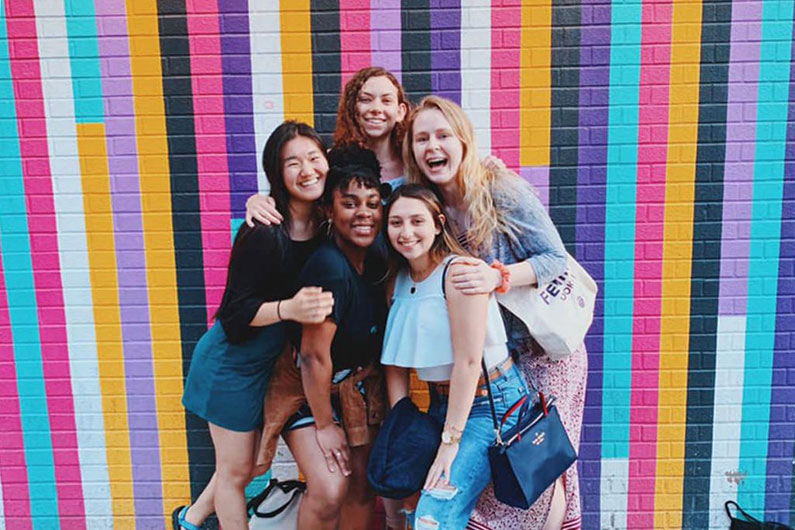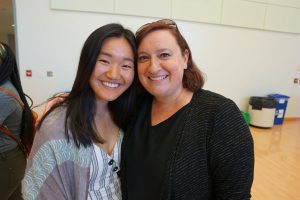UConn inCHIP (Sandra Chafouleas moderates panel discussion around Counseling Not Criminalization in Schools Act)
Q and A: Schooling, Caregiving, and Emotional Support During COVID
UConn Today (Sandra Chafouleas responds to questions on challenges and concerns facing students)
Students Could Have Lost as Much as 183 Days of Learning Time in Reading
The 74 (Kathleen Lynch is quoted about learning losses due to the COVID)
With U.S. Shortage, School Nurses Seen as Crucial During COVID
CT Insider (Sandra Chafouleas is quoted about the importance of school nurses during the COVID)
UConn Women’s Student Leadership Program Receives $1.2M Grant

Editor’s Note: Neag School Board of Trustees Distinguished Professor Sally Reis was instrumental in the development of the BOLD Women’s Leadership Network at UConn. The director of UConn’s BOLD program is educational leadership doctoral student Liza Boritz. The following story originally appeared on UConn Today.
A leadership program for undergraduate women at UConn has proven so successful the funder has donated $1.2 million to extend it for at least three years.
The grant provides scholarships and a transformative experience to several juniors through the BOLD Women’s Leadership Network. The BOLD program cultivates courageous leadership and career success in young women during college and after they complete their studies.
“We look for scholars with leadership potential who have interesting stories to tell and have a passion for an issue of social good,” says Liza Boritz, director of the BOLD program at UConn. “The students get the scholarship award, but also get funding to develop and implement an individualized, service leadership project during the summer between their junior and senior years.”
“It is critical for universities to provide training and opportunities for leadership development for intelligent young women to explore their choices and pursue their dreams.”
— Sally Reis, Board of Trustees Distinguished Professor
The grant is from Helen Gurley Brown’s Pussycat Foundation. Brown, the legendary editor-in-chief of Cosmopolitan magazine, believed that every young woman should have the opportunity to pursue an education and career, and achieve her life’s ambitions.

Xinyu Lin, an engineering major, was one of the first to go through the program and is now doing a BOLD post graduate fellowship. Lin researched and produced a photo story exhibit that documented the experiences of leaders from underrepresented backgrounds in the environmentalism movement.
“The BOLD program has undoubtedly been one of the best parts of my UConn experience,” Lin says. “I’m so glad that I took the chance and applied because it’s given me some of the best mentors, friends, and opportunities I could’ve asked for. BOLD enabled me to pursue a project and topic that wasn’t covered in my coursework, and ultimately inspired me to explore a different career path.”
Cristal Arguello, a junior majoring in urban and community studies, said she was thrilled to be selected for a BOLD scholarship this year.
“It takes away a lot of the financial burden I came into college with. It just takes it away,” she says. “It releases a lot of stress.”
She plans to pursue a project — and perhaps a career — focused on the inhumane treatment of undocumented women and children held at the U.S. border.
One of BOLD’s leaders, Sally Reis, says BOLD plays a key role in helping to develop women as leaders at UConn.
“At a crucial time in our history in which talented women continue to struggle with decisions about how to lead and how to blend family well-being with work responsibilities, it is critical for universities to provide training and opportunities for leadership development for intelligent young women to explore their choices and pursue their dreams,” says Reis, who is a Board of Trustees Distinguished Professor of Educational Psychology.
UConn is one of six colleges and universities across the country in the BOLD network, says Susan Baldridge, lead consultant for the foundation in charge of BOLD.
“It’s been a transformative experience not just for the scholars but also for the faculty and staff,” says Jennifer Lease Butts, director of the Honors Program. “The longer we can keep BOLD as an active program on campus, the greater influence it’s going to have on our community and, ultimately, the world. Leadership for the social good is an increasingly important component of our collective success as individuals and the success of UConn as an institution.”
Talking to Kids About the Dysfunctional Presidential Debate

Editor’s Note: The following originally appeared on Psychology Today, where Board of Trustees Distinguished Professor Sandra Chafouleas launched a new blog this past summer.
“I think that was worse than our seventh-grade mock debate.” That’s what our 14-year-old said after Tuesday night’s presidential debate, which had been assigned by the high school politics teacher to watch and analyze. I murmured agreement as I wasn’t quite sure what else to say at the moment — but woke up the next morning wondering how that ninth-grade teacher was going to handle a class discussion about the debate. Clearly, there was more to talk about beyond the specific campaign issues.
News headlines seem to suggest consensus about how bad the debate was, some deeming it the worst in presidential history and an embarrassment to society. The theme of many stories covering the event can be summed up in a single word: dysfunction. Dysfunctional debates are characterized by not listening, jumping in and cutting others off, grandstanding, boasting, using sarcastic or biting tones, and not acknowledging others.
Putting the political issues aside, the debate brought to light critical lessons about civility — a key piece to social and emotional well-being.
In contrast, healthy debates are characterized by a focus on the issue over the person, seeking other points of view, questioning over lecturing, clearing up points of confusion, and following the set ground rules or norms. Now it was becoming clear to me why I had that nagging feeling about how to proceed in talking about the debate with our kids. Putting the political issues aside, the debate brought to light critical lessons about civility — a key piece to social and emotional well-being.
Civility is about courtesy in our speech and behavior. The purpose of civics education is to teach students about how democratic processes work and how to productively take part in them. According to a 2018 report by the Brookings Institute, civics education outlines a set of practices intended to support students with the knowledge, skills, and attitudes needed to engage in American democracy. Recommended classroom practices include studying such topics as government and current events, but also simulating democratic processes as well as social-emotional learning.
Yes, social and emotional learning is tied to civics. Social-emotional learning is the process through which individuals “understand and manage emotions, set and achieve positive goals, feel and show empathy for others, establish and maintain positive relationships, and make responsible decisions,” per the Collaborative for Academic, Social, and Emotional Learning (CASEL). This learning is pretty important throughout life – it’s tied not only to students’ success in school, but also lifetime outcomes such as graduation rates, emotional distress, and economic mobility.
Civics education that includes debate provides a powerful opportunity to learn about, practice, and receive feedback on social and emotional skills. The challenge is to ensure healthy debate skills – the opposite of what our kids watched this week.
To move forward with our kids, we first need to address the mess that happened this week. We must talk about what happened during this debate of dysfunction, using it as a prime non-example (what not to do) of healthy debate. We also need to push for more civics education in school, teaching our kids the knowledge, skills, and attitudes that they will need to be healthy debaters as adults. Actively embedding social and emotional learning within existing structures for teaching debate is important for all students.
Families (as well as teachers) might consider a couple of possible approaches:
- Find examples of prior debates, and engage your kids in comparing and contrasting the behaviors in healthy — versus dysfunctional — debate.
- Construct a “do-over” for the dysfunctional debate: Take a piece of the debate and rewrite it in a way to show elements of what would exemplify a healthy debate.
- Role-play short mock debates using nonpolarizing “issues” (For example: Should we eat ice cream for breakfast?). Act out dysfunctional as well as healthy arguments and responses, then stop to process how it felt to be part of each experience. These “debating” activities help students develop self-expression, perspective-taking, and critical listening. (For older students, TED has even curated a list of talks that support a healthy debate, many of which are directly connected to topics in social and emotional learning.)
- When a controversial, offensive, or non-inclusive statement is made — whether during the presidential debate, or at home or in the classroom — use a “mark the moment” strategy to pause and paraphrase.
Each of these activities provides us with a teaching opportunity to take a messy debate and recreate it in ways that embed critical social and emotional learning lessons for kids.
For me, this debate was not as much about the campaign issues as it was about behaviors that do not support the positive social and emotional learning that carries us forward into successful adult life at home, work, and social contexts. We cannot let this debate of dysfunction be the model for the next generation.
Talking to Kids About the Dysfunctional Presidential Debate
Psychology Today (Sandra Chafouleas pens commentary about the need for social-emotional learning)
UConn Program Joins Technology and Nature to Build Conservation Awareness
UConn Today (UConn’s Natural Resources Conservation Academy, which Neag School is a partner, is featured)
UConn Women’s Student Leadership Program Receives $1.2M Grant
UConn Today (Sally Reis, leader of the BOLD Women’s Leadership Network, is quoted)
How to Make Teacher Supervision and Evaluation Work with Rachael Gabriel and Sarah Woulfin
Read by Example (Rachael Gabriel and Sarah Woulfin are interviewed about literacy instruction)
